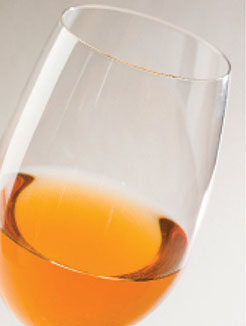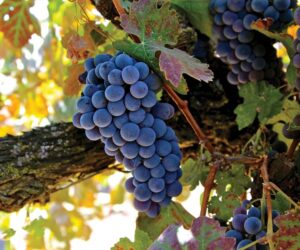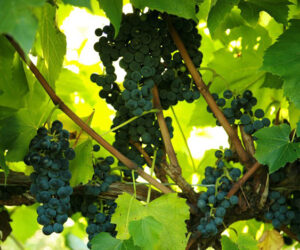 Orange wines are enjoying a bit of a mini craze lately. These are white wines that are purposely exposed to skin contact and oxidized, to produce wines that are quite orange in appearance. But in fact, orange wines have been a thing for around 6,000 years! So, let’s get to the bottom of what makes an orange wine, including the many difficult issues involved in making, marketing, and drinking them, including some professional winemakers’ and historian’s perspectives and tales of orange wine and how it fits into modern winemaking and beverage culture.
Orange wines are enjoying a bit of a mini craze lately. These are white wines that are purposely exposed to skin contact and oxidized, to produce wines that are quite orange in appearance. But in fact, orange wines have been a thing for around 6,000 years! So, let’s get to the bottom of what makes an orange wine, including the many difficult issues involved in making, marketing, and drinking them, including some professional winemakers’ and historian’s perspectives and tales of orange wine and how it fits into modern winemaking and beverage culture.
What is an “Orange” Wine?
An orange wine is defined as a white wine made with extended maceration, with the skins and seeds staying in contact with the fermented wine as it ages, usually in clean ceramic vessels between 7 and 265 gallons (25 and 1,000 liters) in size. Oxidative aromas and bouquet are encouraged, so most orange wine is made without added sulfites (SO2) at crushing or during fermenting/aging.
Orange wine tends to produce specific classic flavors and aromas/bouquets: Robust, bold, dry and tannic/grip with honeyed tropicality (jackfruit), Brazil nut, hazelnut, wood varnish, linseed oil, juniper, sourdough, bruised apple, and desiccated citrus rind. It’s like a compost pile where you mistakenly emptied a paint can, half a sandwich, a bag of nuts, and a bottle of gin.
Classic food matches include curry, bold and flavorful dishes, and especially Ethiopian, Moroccan, Korean, and Japanese cuisine — specifically fermented foods such as kimchi and natto.
One of the most celebrated American orange wines is made by Phil Hart and his wife at AmByth Estate winery in Templeton, California. “We have made orange wine successfully from Grenache Blanc, Viognier, Marsanne, Roussanne, and Sauvignon Blanc,” said Hart; “the Sauvignon Blanc with nine months of skin contact. Of all of those only the Marsanne would be suspect, it’s a huge tannic monster but with time (six years) it is calming down. Any small producer can make orange wine.
The question is how much time on the skins and the answers to that are through experimentation.”
A scholarly perspective on orange wine comes from Dr. Patrick McGovern, America’s preeminent scholar on ancient wine and fermentation:
“Qvevri wine represents a long ancient tradition, reaching back to at least 4000 BC. By burying pottery jars underground, with its cooler temperatures, and fermenting and aging on the lees, very complex and enticing aromas and flavors can be produced,” said McGovern. “Pottery, which was the preferred material in antiquity, yields the compounds by complex oxidation-reduction and enzymatic reactions between the grape juice (must) and the ionic clay. By contrast, modern winemaking is wedded to stainless steel and oak, and is a completely different animal.”
So why make an orange wine? I can only think of two reasons. The first is historic. Being connected in a craft sense to winemakers 6,000+ years ago is appealing and should be amazingly satisfying and educational. The second reason would be that you honestly love the nutty, oxidative, and slightly tannic character of orange wine, and you can’t regularly find or afford a bottle of Gravner Breg Amfora Italian White Blend 2005 from Friuli-Venezia Giulia, Italy — arguably the most vaunted orange wine producer in the world.
Commercial Examples
My palate appreciates orange wine/Qvevri wine, which may surprise you. I have had dozens from winegrowing regions between Caucasian Georgia and the Pacific Coast, but the clear standout for me was an experience with the aforementioned Gravner Breg Amfora Italian White Blend 2005. The wine had impeccable balance and a strong sense of freshness even though it was clearly and purposefully oxidative. It was like reading Oscar Wilde or Hemingway for the first time—unmistakable in form and quality. I look forward to someone else footing the bill for my next Gravner tipple.
A Master Sommelier friend, Will Costello, chimes in: “The first examples [of orange wine] I tried were from Abe Schoener (Scholium Project) and Josko Gravner. Two incredibly eccentric winemakers with experimentation on the brain. I think Abe Schoener’s Scholium Project ‘Prince in His Caves, Farina Vineyard,’ Sauvignon Blanc is an exceptional skin contact Sauvignon Blanc which is as clean and mainstream as can be made in this category. It is entirely 100% whole cluster pressed into head out puncheons and fermented on skins for up to six weeks.”
The Problems with Orange Wine
Let’s now discuss the cons of orange wines, because let’s be honest — you’ve been told many times as a winemaker that your white (and pink) wines should not be orange. Orange wine reminds me of Sherry. Both are funky, oxidative, ancient styles of alcoholic beverages that are considered very important by sommeliers and geeks, and both get a fair amount of press and respect. But very few people actually buy and drink them. Orange wine and fine Sherry remind me of Mark Twain’s definition of a classic work of literature: “A book that people praise but don’t read.” Orange wine is also very un-modern. Today’s winemakers tend to like to make squeaky-clean, fruit-forward wines, which couldn’t be more stylistically opposed to the “natural” and distinctly earthy/funky ancient style of orange wine. It takes way too much time and patience to be useful to most winemakers, and the flavor profile can be kindly described as uniquely oxidative. To the lion’s share of wine drinkers in the world, orange wine is not just an oddity, it’s undrinkable. Much of the bouquet in orange wine is what we recognize as faults in our own winemaking craft — the premature oxidation, volatile acidity, ethyl acetate, Sherry-like nuttiness would normally cause us to toss a batch down the drain. In orange wine these aromas are not only typical, but de rigeur.
Also, most wine drinkers consider fruit character in wine to be their primary qualitative asset. Imagine a Parker review of a wine over 90 points without descriptions like, “Oozing with ripe and heady blueberry and kirsch fruit.” We have a love affair with very fruty wines. But with lots of patience, work, and a Chalcolithic (late Neolithic, or Copper Age) ceramic vessel called a ‘Qvevri’ (usually about 200 gallons/ 800 liters) you too can bury your wine for years, give it a bitter/phenolic character, obliterate the bright fruit character of a wine and make those five hipster sommeliers that buy and drink orange wine very, very happy.
The Future for Orange Wines
I’ve properly and adequately marginalized the current popularity of orange wine, supported by the fact that orange wine doesn’t even warrant its own category in American wine sales. After nearly an hour of searching for statistics on orange wine economics, I couldn’t find a single study or publication where orange wine/macerated white wine deserved a mention. So let’s concede that this is not a wine that’s going to make anyone rich and famous. The most enthusiastic quote I could find from a buyer/sommelier who loves to put orange wine on her list was “They’re here to stay,” said Rouge Tomate, Chelsea, wine director Pascaline Lepeltier. Yep.
Orange Wine Recipe Tips
•Choose a white wine varietal such as Sauvignon Blanc, Grenache Blanc (or other white Rhône), Pinot Blanc, Pinot Gris/Grigio, Sémillon or any white you love to drink and is available to you from a quality vineyard source.
•Sanitation/cleanliness of the grapes is absolutely vital! Whatever is on/in the grapes when you crush and destem, will be in the wine for its entire extended maceration. As noted by Master Sommelier Will Costello of Bien Nacido Estate, “Anyone interested should start with as healthy a grape crop as possible. The opportunity to create off flavors and aromas with native yeast and stuck ferments is directly related to health of the crop.”
•Carefully sort the fruit before it goes into the crusher/destemmer. Omit any clusters with mildew, rot, insect, or bird damage.
•Crush the fruit into a fermentation vessel. Tradition prefers ceramic for its strong ionic influence on flavor development and enzymatic reactions. Ceramic does have sanitation issues, and many wines made in this style are ruined by clay vessels harboring unwanted microbes from previous winemaking, storage, or environmental contamination. Clean and reclean, sanitize carefully, and I would burn lots of sulfur into the vessel just before filling. (This may be against the ideals of natural winemaking, but I don’t care if it keeps the wine sound.)
•I would cover the fermentation to keep out fruit flies, etc. A “Native/feral” fermentation is preferred. If your must doesn’t start bubbling in 2–3 days, I would inoculate with a commercial yeast — CY3079 or GRE come to mind for me. I would suggest avoiding Bayanus yeast strains (EC-1118, for example) which are a little too efficient for an extended maceration.
•Once the wine is dry, keep it covered for a few extra days/week to make sure there is no longer active fermentation in the vessel. You can put a bit of the must in a jar and see if it pressurizes.
•Seal the fermenter, airtight, and leave for a few weeks, months, or even years. The longer you leave the wine in contact with the skins, the more earthy, Sherry-like, honey/nutty, astringent, and golden it will become. The amber/orange color is mostly extracted from seed lignins.
•In a purely traditional system, you would ferment in an open top (covered with cloth/bungee to allow off gassing but no insects) until dry, and then seal the Qvevri/vessel and bury it so the top of the fementer/Qvevri is completely underground. This is done traditionally to moderate temperatures, and in a perfect world you could ferment the wine underground too, keeping the top of the vessel unburied until the wine is dry and then seal the vessel (traditionally with clay or beeswax).
•Now, here’s my issue with this process. While making your first orange wine, how would you know how much time in a sealed vessel is enough time to give us the style we want? My suggestion is to go a few (2–3) weeks on your first batch, and if it isn’t funky enough, add a week or two in each subsequent vintage.
•Press the wine, rack a few times and then bottle. SO2 is optional, I would add enough for 0.8 molecular stability, but what do I know? I trust science and Pasteur, enough to get summarily flogged at a meeting of the Natural Wine people.
Orange Wine Case Study
by: Stephen Franzoi
The process of orange winemaking — or orangeism — is more accurately conceived of as an umbrella term that describes a form of white winemaking that encompasses a number of techniques, some more extreme than others. In one mild form of orangeism, the vintner crushes white grapes and then chills the juice with the skins (and perhaps with the stems, based on the winemaker’s preferences) for a period of time before fermentation. Leaving the skins on prior to fermentation gives the juice a golden hue, while also adding tannins and complexity normally found only in red wines. A moderate form of orangeism involves leaving the skins on throughout the fermentation process, just like in red winemaking, resulting in more color and tannin extraction. In an extreme form, the vintner engages in extended skin maceration far beyond fermentation, into long-term bulk aging.
Orange wines are made from a wide variety of white wine grapes throughout the world, including Italy, Croatia, Slovenia, and certain areas in France. Beyond its current trendiness, the appeal that orange wine has among some winemakers is that the technique used to create it coaxes a bit more flavor and complexity from the grapes without losing their sense of origin. In other words, the grape variety used in making the wine is still recognizable, but it now also has some unique flavors.
Making Orange Wine at Home
Now let’s examine making an orange wine. For this experiment, I used a cold-climate grape variety that is a solid candidate for orange winemaking, Catawba. This venerable grape is the oldest North American hybrid, generally recognized as being a cross of labrusca and vinifera species, and was the most planted variety in the United States up until the 1860s. In the Midwest, Catawba yields large pinkish berries with medium-sized clusters and a “foxy” labrusca character. It ripens late, and is mostly processed like a white wine grape; i.e., it is not fermented on its skins. Yet when winemakers do practice skin fermentation, the resulting Catawba wine is pink to orange in color, with noticeable tannin taste.
At the end of September in 2015 I harvested 100 pounds (45 kg) of Catawba grapes from my backyard vineyard and crushed them so the skins and stems remained with the juice, yielding about 8 gallons (30 L) of must. I added a half-teaspoon of potassium metabisulfiite and six hours later I added pectic enzyme. After a few hours I took some measurements and discovered the Brix was only at 12.4 (specific gravity/SG of 1.050 and the pH was also low at 2.56), but one benefit of under-ripe Catawba grapes is that their sometimes off-putting foxy character is not as pronounced. To reduce the acidity, which was at a whopping 1.10 percent, I ameliorated the must by adding 1.5 gallons (5.7 L) of water, which accounted for 21% of the volume in the final 7 gallons (26 L) of wine; total acidity was now 0.90 percent and pH was 2.85. To increase the sugar level of the must, I added about 7 pounds (3 kg) of white cane sugar, resulting in a starting Brix of 21.6 (SG 1.090).
I used Lalvin DV-10 yeast, and I also added 20 grams of Scott Laboratories’ Opti-White as a yeast nutrient that enhances smoothness, helps avoid browning from oxidation, and protects fresh aromas during aging. Virtually everything I read about orange winemaking recommended a cool fermentation. Cooler temperatures are more likely to retain delicate aromas and flavors in the grape. Given the cool fall weather, I was able to easily commence a cool fermentation on my front porch.
After five days of skin-contact fermentation at a temperature of under 60 °F (15 °C) the sugar level was at 10° Brix (SG 1.040). I pressed the juice off the skins and stems and then racked off the gross lees one week later when fermentation was complete. Normally when I press red wine I rack it off its gross lees within 48 hours, but my orange wine was still actively fermenting, so I decided to extend the lees contact time with the juice until fermentation was nearly complete. Following racking, the young wine definitely had a murky-orange color. Four weeks later, after cold stabilizing the wine, I racked it off the fine lees and added potassium metabisulfite; the color was now a tawny hue and the specific gravity was 0.995, yielding a final alcohol level of about 12%. Nine months later, I added Super Clear for fining and racked the wine off its sediment three weeks later. Now the wine had a clear light-tawny color.
Prior to bottling I filtered the wine and then measured my free sulfite level to determine how much potassium metabisulfite to add to the finished wine. So why did I use sulfite throughout my winemaking, given that a considerable number of commercial winemakers eschew such additions when creating this wine style? My answer is that I simply did not want to invite unwanted organisms into this beverage, so I made sure to add only the minimal amount of sulfite to ensure healthy aging. I also added 8 grams of gum arabic to the 7 gallons (26 L) of finished wine just prior to bottling to soften its acid bite. The final pH level was 3.00.
At bottling, the wine had a robust grapefruit and bruised apple aroma and taste, along with high acidity and moderate tannins. I also thought I perceived a hint of oxidation, but none of my colleagues at the Wisconsin Vintners Association noticed this quality, so perhaps it was simply my imagination. Six months later, at a second tasting, I again perceived a grapefruit aroma and taste along with a sourdough quality, as well as a lingering, butterscotch aftertaste that reminded me of an old Chardonnay. It will be interesting to see how these aroma and taste compounds change over the coming months and years. I’m betting that this wine has good aging potential, but only time will tell.







